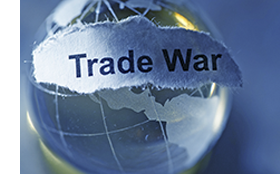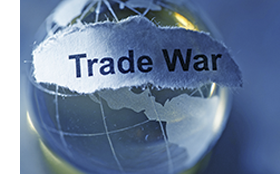A primer on how to navigate the changes
In the past few months, phrases like “tariffs on Chinese imports” and “trade war with China” have been floating around in the news. The government levied a 25 percent tariff on over $50 billion of products imported from China.
A tariff is a tax or duty paid on a particular class of imports or exports.
 The newly imposed tariffs could increase the cost of doing business for many business owners and consequently lead to rising prices for goods and services in the U.S. Will your wallet be impacted? Read on for a quick primer on recent tariff legislation and steps you can take to mitigate your risk of being negatively impacted.
The newly imposed tariffs could increase the cost of doing business for many business owners and consequently lead to rising prices for goods and services in the U.S. Will your wallet be impacted? Read on for a quick primer on recent tariff legislation and steps you can take to mitigate your risk of being negatively impacted.
Recent Developments
In response to allegations of China’s unfair trade practices, the U.S. imposed tariffs on over $50 billion of Chinese products. The tariffs were targeting capital and intermediary products, while consumer products accounted for only about 1 percent of the products hit with tariffs. The main goals of the tariffs are to influence China to rework trade agreements, and to make American companies use far fewer Chinese products in their manufacturing and supply chain processes. This initial wave of tariffs came in two sets.
The first set of tariffs were issued on July 6 as a 25 percent additional tariff on $34 billion of Chinese goods. The focus was to impose the duty on raw materials and intermediary goods used in the manufacturing process. There were about 1,102 categories of products affected, such as aircraft tires, aircraft engines and parts, plows, mowers, some cars and trucks and medical equipment.
The second set of tariffs went into effect on Aug. 23, when the government issued an additional 25 percent tariff on $16 billion of Chinese goods. This round of tariffs effected 279 product lines, and again, left consumer goods mainly untouched. A few of the products affected in this round are lubricating oils, resin, plastic tubes, tractors and industrial chemicals.
Impact on Business Owners
So far, business owners will be most directly impacted during the initial stages of the new tariff enforcement. Any business that uses components in its supply chain that are subject to the new tariffs will see a very significant increase in the cost of producing their goods and services if they continue using Chinese suppliers. Even if a company decides to use alternative supply sources to obtain those same products, there is a good chance that the price to be paid for those products will still be higher than what they have been used to in the past. Business profits could fall a bit if the tariffs remain in place for any significant amount of time.
However, some American businesses could potentially be winners as a result of the tariffs, if they produce products that are now subject to the additional 25 percent duty. If the new tariffs increase the price of the Chinese produced product to the point where the American made option is the cheaper option, then those American businesses could see a boost in sales. Those businesses would feel a lot less competitive pressures and may have some leeway to raise their prices as well.
Impact on Consumers
Although the recent tariff legislation was created in a manner to avoid impacting consumer products, consumers could still end up being indirectly impacted. Producers of consumer products will only be able to absorb their increased cost of doing business for a short time. Once a business burns through inventory purchased at the old lower prices, they will have to pass some of the increased costs on to the consumer with a price increase on the products they sell. Therefore, consumers could feel the financial pain brought on by the tariffs through an increase in prices.
Action Steps to Mitigate Your Risk
There are a few action steps that you can take to help your company successfully navigate the changes brought on by the new tariffs.
- Map out your entire supply chain system so you can determine which products will be impacted as a result of the tariffs.
- Once you determine which products will be impacted, you should complete a projection of the potential increase in costs you will experience.
- Look for alternative non-Chinese suppliers from which you can purchase products.
As there is a lot of uncertainty regarding the new tariffs, it is important to stay current with future developments. The U.S. and China continue to issue threats to one another and retaliatory actions, including additional tariffs, will continue to be a concern.
Currently, the U.S. is considering issuing another round of tariffs that would impose an additional 25 percent duty on $200 billion of additional Chinese products. Many consumer products, such as meat, fish, vegetables, tobacco, perfumes, aluminum, televisions, furniture and some clothing items may be directly impacted by this next round of tariffs. If passed, the third round of tariffs would subject almost half of the total Chinese imports tariffs. However, this round of tariffs has not been passed and is only in the discussion phase.
If you have any questions about this topic, please contact a member of our Zinner team.





